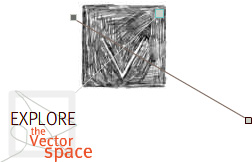Tracking Theory
The Synthetic Philosophy of The Glance
Author's Statement
BACKGROUND
Wolfgang Schivelbusch's book The Railway Journey inspired this project; In this intellectual history of the railroad's invention, Schivelbusch traces how rail travel radically changed our perception of space and time in the 19th century.
As a film studies scholar, I was interested in how the railroad's reconfiguration of human perception neatly segued with the temporal and spatial possibilities introduced by cinema's invention in the late 19th century. Indeed, the perceptual changes suggested by Schivelbusch -- the ability to "instantaneously" travel between distant locations, the shrinking and expanding of scale and space, the standardization of time, direct experience replaced by virtual experiences -- all see their fulfillment in early cinema.
Yet, Schivelbusch's book remains abstract largely because he discusses perceptual changes via a literary medium. My idea with Tracking Theory was to provide a visual, scholarly "illustration" of Schivelbusch's ideas through the medium of film and video. In short, what would the ideas behind The Railway Journey look like as a film instead of a book? What possibilities emerge in visual scholarship?
Christian Keathley of Middlebury College provided me the forum to experiment with the above questions when he organized a panel for the 2006 Society for Cinema and Media Studies conference in Vancouver. The panel topic was "The Video Essay" and the panelists (Keathley, myself, Michael Jarrett from Pennsylvania State University York, and University of Pennsylvania's Timothy Corrigan) created short sample films that imagined film studies scholarship as a visual medium.Tracking Theory was my response.
APPROACH
With a time limit of 10-13 minutes, I set two major goals for this work. First, I wanted to obviously suggest some visual corollaries to Schivelbusch's work. Second, I wanted to explore the possibilities suggested by "the essay" and early cinema. Given early cinema's diversity of genres and approaches (freely mixing narrative, spectacle, actuality, and fiction), my film's subject matter seemed to neatly fit with the essayistic form.
I also liked the video essay's refiguring of artist and audience relationship. While the idea of "interactive" media has been much hyped in recent years, it seems to me the "essay" film has long existed as an interactive form. Unlike traditional Hollywood narrative and its more homogenous, disposable, and formulaic approach, the essay film intentionally invites the audience to probe, re-view, and question the film's content and style. For me, much of today's interactive media design requires interactivity of hands and mouse but not necessarily the brain. I wanted to use a familiar, perhaps even dated, media form (the movies) but in a different way (the essay).



